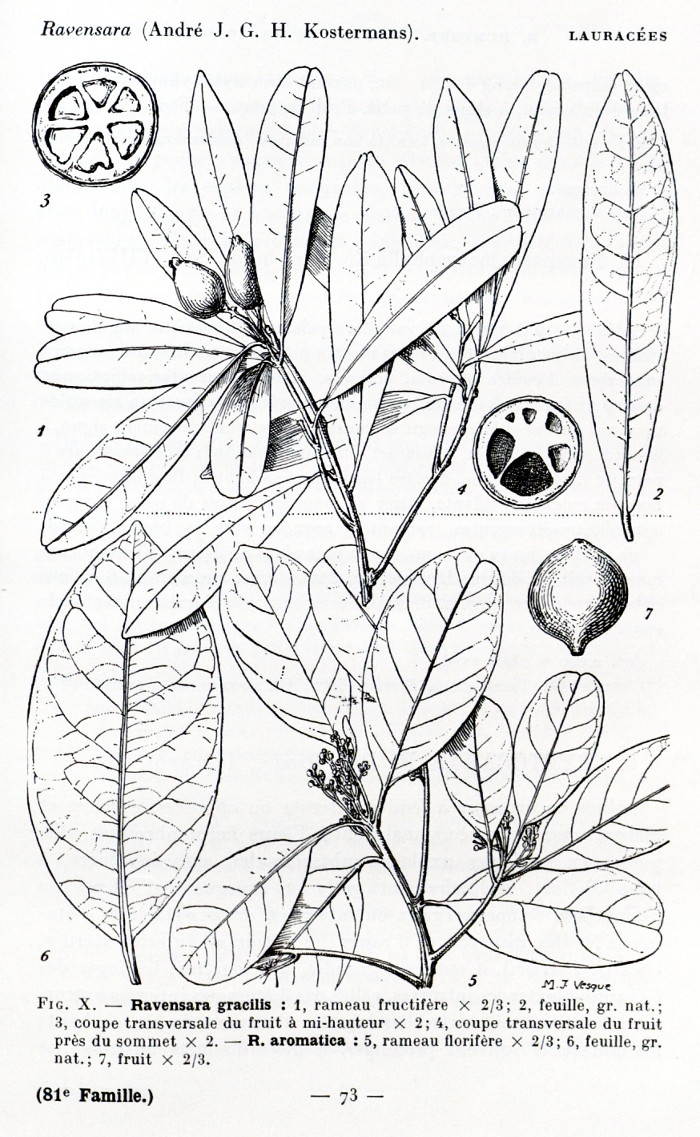Dies ist eine alte Version des Dokuments!
Cryptocarya agathophylla van der Werff - syn.Ravensara aromatica Sonn.; Agathophyllum aromaticum (Sonn.) Willd.- Lauraceae
ravensara, clove nutmeg, Madagascar nutmeg, Madagascar-Muskatnuss, Ravensara
Evergreen tree, endemic to Madagascar.
„Ravensara is a latinisation of the Malagasy word ravintsara and was generally given to the oils distilled from either ravensara aromatica or cinnamonum camphora. Recent research in the chemical make-up of these 2 oils has lead to give each of them a clear botanical identity. The leaf oil from Agatophyllum aromaticum has kept its common name of Ravensara and its botanical name of 'Ravensara aromatica' and the oil from cinnamonum camphora has been given the common name of 'Ravintsara'.“ http://materiaaromatica.com/default.aspx?go=article&articleID=187
„For many years, various articles alerted on confusions concerning the commercial batches of essential oils of Ravensara aromatica and Ravintsara (Cinnamomum camphora). Recent work has, moreover, highlighted the existence of five different essential oils chemotypes from the species Ravensara aromatica, which still adds to the confusion. The fifth chemotype identified is described for the first time in this article. The purpose of this research was to check the continuance of this confusion among the essential oils sold in Madagascar and in the North countries. Thirty four commercial batches of essential oils whose labelling refers to Ravensara or Ravintsara were gathered between 2009 and 2011. The information related to the label was analyzed and the chemical composition of the samples was determined by gas chromatography, gas chromatography coupled with mass spectrometry and compared with reference samples. The results show that the essential oils sold in Madagascar under the designation of Ravintsara and Ravensara aromatica/ Ravensara anisata are authentic volatile extracts of Ravintsara and Ravensara. In the North countries, the situation is different. Oils of Ravintsara are generally well labelled. But among fourteen samples labelled Ravensara aromatica or Ravensara anisata, only five were authentic essential oils of Ravensara. This confusion, associated with the natural chemical variability of the essential oils of Ravensara and with the problems related to the exploitation of an endemic species of a south country (threat on the resource, weak remuneration of the collectors), raises the question of the durable exploitation of this species.“
[Ravensara aromatica ou Ravintsara : une confusion qui perdure parmi les distributeurs d’huiles essentielles en Europe et en Amérique du Nord. H. Andrianoelisoa, C. Menut, P. Danthu, Phytothérapie, Vol.10(3), 2012, 161-169]
„A commercial essential oil of Ravensara anisata examined by GC/MS, is dominated by methyl chavicol (61.62%) and (E)-anethole (20.09%), while a commercial oil of R. aromatica is dominated by 1,8-cineole (30.97%), sabinene (17.23%) and α-terpineol (10.34%).“
[Two commercial oils of Ravensara from Madagascar: R. anisata Danguy and R. aromatica Sonn.(Lauraceae). Tucker, A. O., Maciarello, M. J., Journal of Essential Oil Research, Vol.7(3), 1995, 327-329]
„Five leaf essential oils of Ravensara aromatica Sonn. from Madagascar have been analyzed by GC and GC/MS. They were found to contain mainly methyl chavicol (79.7%), methyl eugenol (8.5%) and limonene (3.1%).“
[Chemical composition of Ravensara aromatica Sonn. leaf essential oils from Madagascar. Ramanoelina, P. A., Rasoarahona, J. R. E., Gaydou, E. M., Journal of Essential Oil Research, Vol.18(2), 2006, 215-217]
„The chemical composition of essential oils obtained by hydrodistillation of leaves and bark (taken individually, tree by tree) of Ravensara aromatica Sonnerat of Madagascar was investigated by gas chromatography and gas chromatography coupled with mass spectrometry. Results were treated by principal component analysis. Four chemotypes highlighted about leaves in an earlier work were confirmed: chemotype 1 (> 90% methyl chavicol), chemotype 2 (72–80% methyl eugenol), chemotype 3 (25–28% α-terpinene) and chemotype 4 (25–34% sabinene). The chemical composition of R. aromatica bark is in all cases characterized by a high amount of methyl chavicol (83–98%), whatever the chemotype. One can conclude that the bark oil of R. aromatica corresponds to the oil described previously under the name “oil of R anisata.”
[Chemical composition of essential oils from bark and leaves of individual trees of Ravensara aromatica Sonnerat. Andrianoelisoa, H. S., Menut, C., Ramanoelina, P., Raobelison, F., De Chatelperron, P. C., Danthu, P., Journal of Essential Oil Research, Vol.22(1), 2010, 66-70]

Ravensara gracilis )above) and Cryptocarya agathophylla (as Ravensara aromatica)
Flore de Madagascar et des Comores, Lauracées, vol.81 Lauracées, p.73 (1950) [M.J.Vesque]
http://plantgenera.org/species.php?id_species=294950
